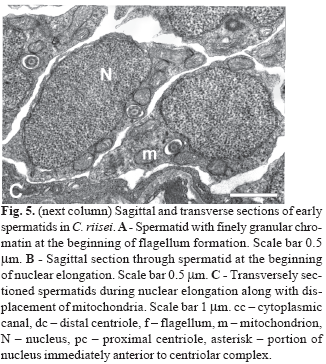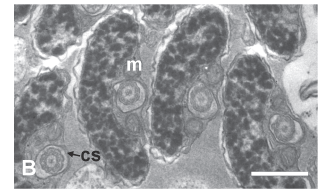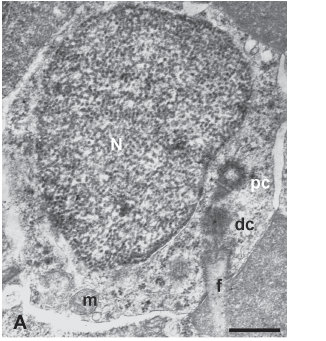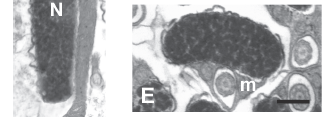Spermiogenesis and sperm ultrastructure were analyzed in two species of characids with different modes of fertilization: externally fertilizing Hemigrammus erythrozonus and inseminating Corynopoma riisei. Spermiogenesis in H. erythrozonus is characterized by lateral development of the flagellum, nuclear rotation, formation of a shallow nuclear fossa, condensation of the chromatin by elimination of the electron-lucent area from the peripheral region of the nucleus, and renewal of the nuclear membrane. Multilammelated membrane and multivesicular bodies were also observed during elimination of the excess cytoplasm. The spermatozoon exhibits characters typical of "aquasperm," i.e. a spherical head containing a spherical nucleus with highly condensed chromatin, several small mitochondria located at the base of the nucleus within a cytoplasmic collar that extends into a long cytoplasmic sleeve surrounding the anterior part of the single flagellum, which is contained within a cytoplasmic canal. The flagellum lacks fins. The proximal and distal centrioles are nearly parallel to one another, with the anterior tips of both located within shallow nuclear fossae. Spermiogenesis in C. riisei is characterized by nuclear elongation alongside the forming flagellum, formation of an elongate cytoplasmic canal, displacement and elongation of the mitochondria, and uniform condensation of chromatin throughout the nucleus through enlargement of the diameter of the chromatin granules. The spermatozoon has an elongate nucleus with two elongate mitochondria localized to one side. Mitochondria are also located posterior to the nucleus forming a mitochondrial region. The single flagellum, which lacks fins, is lateral to the nucleus and initially contained within the greatly elongate cytoplasmic canal before exiting the canal at its posterior terminus. The spermatozoon of C. riisei exhibits several characters typical of "introsperm," such as an elongate nucleus and midpiece (mitochondrial region). The nuclear chromatin in the spermatozoon remains "flocculent" and is never as condensed as that seen in many characid sperm. Differences in spermiogenesis between externally fertilizing and inseminating characids are discussed.
Nuclear rotation; Aquasperm; Introsperm; Characids




























